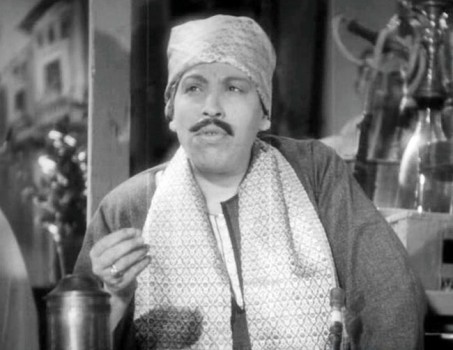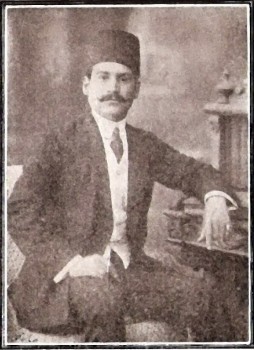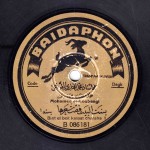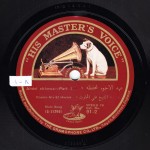The Arab Music Archiving and Research foundation (AMAR), in collaboration with the Sharjah Art Foundation (SAF), presents “Sama‘ ”.
“Sama‘ ” discusses our musical heritage through comparison and analysis…
A concept by Mustafa Said.
Dear listeners,
Welcome to a new episode of “Sama‘ ”.
Today we will resume our discussion about dawr “ ‘Ahd el-ukhuwwa niḥfaẓu” written by Ismā‘īl Bāshā Ṣabrī and composed by ‘Abduh al-Ḥāmūlī.
We announced that we would be analysing eight recordings.
We ended our previous episode saying that the dawr (semi-composed metric song) is simple and that each one may deal with it at whim, whether in the tafrīd (improvisation), the waḥāyid (responsorial part between the singer and the chorus), or the qafla (conclusion)… and listening to ‘Alī al-Ḥārith’s strange qafla.
Today, we will start by discussing the pace/speed of the dawr:
Most of our recordings of dawr-s highlight a significant difference between disc recordings and the recordings of, for example, the Arab Music Band or the National band led by ‘Abd al-Ḥalīm Nuwayra: in discs, the performance is lively, fast, and includes continuous innovation, except in the case of some muṭrib-s (singer-s) whose slow performance is an attempt to imitate another disc, yet at a slower pace. This is illustrated in the collective singing of the National band that performs the dawr very slowly and segments the lyrics differently…the speed is almost null, so is the liveliness. Furthermore, since the singing is collective and the dawr initially relies on dialogue, consequently there isn’t any type of instant innovation.
Let us see this in our recordings and listen to the recordings of ‘Abd al-Ḥayy and of ‘Alī al-Ḥārith …
(♩)
Liveliness… Speed…
Let us now listen to two recordings of Ṣāliḥ ‘Abd al-Ḥayy …
(♩)
I think that the second recording is slower than the first one because he was older and had less energy… In fact, he died two or three years later… or four at the most. He was older and slowed down the rhythm because he was calmer.
On the other hand, nothing can explain the exaggerated slowness of collective singing… that is even slower than in the last recording of Ṣāliḥ ‘Abd al-Ḥayy.
Let us go back to Ṣāliḥ ‘Abd al-Ḥayy and his relation to ‘Abd al-Ḥayy Ḥilmī.
Let us listen to the dakhla (overture) starting from the tafrīd up until “lāḥ lī bi-waghak yā amar” by ‘Abd al-Ḥayy …
(♩)
Now by Ṣāliḥ…
(♩)
Exactly the same! It also seems that Ṣāliḥ is a member of the biṭāna (chorus) that answers ‘Abd al-Ḥayy.
The same applies to “Yā amar” …
(♩)
Let us listen again the ‘Abd al-Ḥayy’s phrase in order to hear the instrumental interpretation by Sāmī al-Shawwā and Muḥammad ‘Umar who play a beautiful segmented rhythm. I wish Ṣāliḥ ‘Abd al-Ḥayy’s band had benefitted from this recording …
(♩)
Beautiful lively interpretation!
Let us listen to ‘Abd al-Ḥayy’s beautiful improvised part “ṭāli‘ su‘ūdak gadd bi-el-naṣr fō’ el-ḥadd” to the ṣabā…
(♩)
As we heard, this is shared by both recordings.
On the other hand, in the BBC recording –the only recording where he does this–, he sings “Asma‘ kalāmuh in amar” to the rāst kardān which is the maqām’s fourth since he is singing to the bayyātī nawā.
So let us listen to him in “Asma‘ kalāmuh in amar” when he ascends to the jawāb rāst –the jawāb kardān in this case–, and settles on it twice …
(♩)
Beautiful!
The second recording was made more than one decade after the previous one, so he was obviously tired and did not sing this phrase at all, neither did he in any of his 1950s’ recordings. It is specific to this recording, and I think also to Ṣāliḥ ‘Abd al-Ḥayy.
Except for ‘Alī al-Ḥārith’s khātima, all the khātima-s either by Ṣāliḥ ‘Abd al-Ḥayy or by ‘Abd al-Ḥayy Ḥilmī are almost the same.
Let us listen to the three khātima-s …
(♩)
After the khātima-s, let us listen to the dawr as it was sung live by Ṣāliḥ ‘Abd al-Ḥayy. The 1950s recording is in fact a waṣla (musical suite) including muwashshaḥ (instrumental and vocal form) “Imlālī el-aqdāḥ” and layālī (sung improvisation on the words yā lēl yā ‘ēn (O night, O eye)) preceded by taqsīm-s (improvisation instrumental type) and samā‘ī bayyātī al-‘aryān.
Yet, I suggest we play his BBC recording that starts with a bayyātī melody in the form of a dūlāb (binary metrical brief instrumental prelude) –but not a dūlāb– after which he directly started the dawr that he took his time singing –more than 15 minutes–.
Let us listen to this beautiful performance and note his relationship with the biṭāna (chorus), added to the beautiful tafrīd in which he modulated from the bayyātī’s first to the bayyātī’s fifth, i.e. the ḥusaynī. The dawr is to the bayyātī ḥusaynī –not the ḥusaynī– that includes a ‘ushshāq aspect –which is ordinary– and focuses on the maqām’s fifth along with the presence of the ‘ushshāq aspect, i.e. he performs a maqām (musical mode) resembling the maqām kurd. Yet, he plays to the bayyātī when he reaches the fifth scale-step, not to the kurd. So he fully modulated to the ḥusaynī. He did this in the tafrīd then performed a taslīm (bashraf and samā‘ī ritornello) to the hank (responsorial part of improvisation between the singer and the chorus), i.e to the dialogue with the biṭāna, from the bayyātī’s fifth. He plays to the bayyātī, then to the ṣabā, then to the rāst in “asma‘ kalāmuh in amar” and goes back beautifully with “ṭāli‘ su‘ūdak gadd”.
Let us listen to Ṣāliḥ Afandī ‘Abd al-Ḥayy accompanied by Labīb Ḥasan (violin), Muḥammad ‘Abduh Ṣāliḥ (qānūn), ‘Abd al-Fattāḥ Ṣabrī (‘ūd), maybe Ḥāmid Mursī and Muḥyiddīn al-‘Arabī among other biṭāna members I do not know, and Ibrāhīm ‘Afīfī (percussions).
We end today’s episode of “Sama‘ ” with Ṣāliḥ ‘Abd al-Ḥayy.
We will meet again in a new episode of “Sama‘ ” to discuss, study, and analyse a new work.
Here is Ṣāliḥ ‘Abd al-Ḥayy with his band…
(♩)
“Sama‘ ” was presented to you by AMAR.
- 221 – Zakariyya Ahmed – 12 (1/9/2022)
- 220 – Zakariyya Ahmed – 11 (1/9/2022)
- 219 – Zakariyya Ahmed – 10 (11/25/2021)
- 218 – Zakariyya Ahmed – 9 (10/26/2021)
- 217 – Zakariyya Ahmed – 8 (9/24/2021)
- 216 – Zakariyya Ahmed – 7 (9/4/2021)
- 215 – Zakariyya Ahmed – 6 (8/28/2021)
- 214 – Zakariyya Ahmed – 5 (8/6/2021)
- 213 – Zakariyya Ahmed – 4 (6/26/2021)
- 212 – Zakariyya Ahmed – 3 (5/27/2021)
- 211 – Zakariyya Ahmed – 2 (5/1/2021)
- 210 – Zakariyya Ahmed – 1 (4/28/2021)
- 209 – W-al-Lāhi lā astaṭī‘u ṣaddak 2 (4/6/2017)
- 208 – W-al-Lāhi lā astaṭī‘u ṣaddak 1 (3/30/2017)
- 207 – Bashraf qarah baṭāq 7 (3/23/2017)




